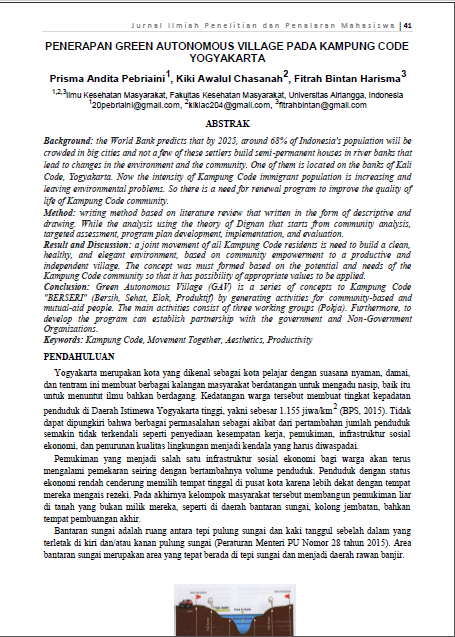PENERAPAN GREEN AUTONOMOUS VILLAGE PADA KAMPUNG CODE YOGYAKARTA
Main Article Content
Abstract
Background: the World Bank predicts that by 2025, around 68% of Indonesia's population will be crowded in big cities and not a few of these settlers build semi-permanent houses in river banks that lead to changes in the environment and the community. One of them is located on the banks of Kali Code, Yogyakarta. Now the intensity of Kampung Code immigrant population is increasing and leaving environmental problems. So there is a need for renewal program to improve the quality of life of Kampung Code community.
Method: writing method based on literature review that written in the form of descriptive and drawing. While the analysis using the theory of Dignan that starts from community analysis, targeted assessment, program plan development, implementation, and evaluation.
Result and Discussion: a joint movement of all Kampung Code residents is need to build a clean, healthy, and elegant environment, based on community empowerment to a productive and independent village. The concept was must formed based on the potential and needs of the Kampung Code community so that it has possibility of appropriate values to be applied.
Conclusion: Green Autonomous Village (GAV) is a series of concepts to Kampung Code "BERSERI" (Bersih, Sehat, Elok, Produktif) by generating activities for community-based and mutual-aid people. The main activities consist of three working groups (Pokja). Furthermore, to develop the program can establish partnership with the government and Non-Government Organizations.
Article Details
References
Aryenti. 2011. Peningkatan Peran Serta Masyarakat melalui Gerakan Menabung pada Bank Sampah di Kelurahan Babakan Surabaya, Kiaracondong Bandung. Bandung: Pusat Litbang Pemukiman.
Ayodia, Natalia Riza Putri. 2014. “Model Kebijakan Pemukiman Kampung Code Utara di Tepi Sungai Code”. Jurnal Pembangunan Wilayah dan Kota. Volume 10 (1). (Semarang, Maret).
B., Widodo, Ribut L, dan Donan W. 2010. Pengelolaan Kawasan Sungai Code Berbasis Masyarakat. Jurnal Sains dan Teknologi Lingkungan 2(1): 19. ISSN: 2085-1227.
Bappeda Kota Yogyakarta. 2009. Rencana Aksi Ruang Terbuka Hijau.
Blanc. P. 2008. The Vertical Gardens: From Nature to The City. W.W. Norton & Company.
Dignan, M.B., and Carr, P. A. 1992. Program Planning for Health Educational adan Promotion 2nd Edition. USA: Lea and Febiger.
Direktorat Jenderal Departemen PU. 2006. Ruang Terbuka Hijau.
Peraturan Menteri Pekerjaan Umum Nomor 05/PRT/M/2008 Tentang Pedoman Penyediaan dan Pemanfaatan Ruang Terbuka Hijau di Kawasan Perkotaan
SNI. 2004. Tata Cara Perencanaan Lingkungan Perumahan di Perkotaan.
Unilever Green and Clean. 2010. “Bank Sampah dan Program Lingkungan Yayasan Unilever”.
http://www.unilevergreenandclean.co.id/greenand clean. Yayasasan Unilever Indonesia.
Werdiningsih. Hermin. 2007. “Studi Pola Ruang Terbuka Hijau di Lingkungan Perumahan Semarang”. Jurnal Ilmiah Perancangan Kota dan Pemukiman 6 (2).

